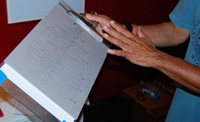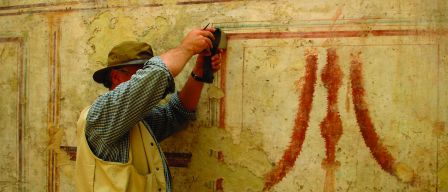Dr. Raymond Hayes, Underwater Archaeologist, made a major discovery in his investigation of shipwrecks. He found a quick, non-destructive method to analyze them - Handheld XRF. He can now study specimens where he finds them, even when they are moving on platforms off shore, like on boat decks. He no longer has to remove a piece from the wreck and send it off to a lab for analysis. He can simply analyze artifacts on-the-spot without harming them. Dr. Hayes analyzes wooden shipbuilding materials including oakum, Irish felt, pine tar, caulking cotton, copper sheathing, treenails, and metal fasteners. He studies raw lumber, ship timbers, and various wood treatments for comparative baseline data. Shipwrecks he's studied include the Gunboat Philadelphia, Boca Chica Channel Wreck, USS Scorpion, Cleopatra's Barge or Pride of Hawaii, Charles W Morgan, Indiana, USS Tulip, USS Housatonic, CSS Neuse and the CSS Alabama. | 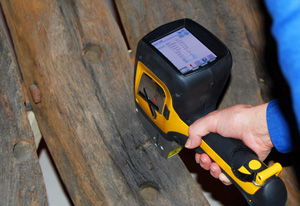 |
Sparrow-Hawk: The 1626 Shipwreck
Dr. Hayes recently had the opportunity to study the Sparrow-Hawk which is housed at the Cape Cod Maritime Museum in Hyannis, MA. He was assisted by Executive Director, Janet Preston. They were joined by representatives of Sparrow-Hawk's owner, the Pilgrim Hall Museum in Plymouth, MA: Ann Berry, Executive Director, and Stephen O'Neill, Associate Director and Curator of Collections. The Sparrow-Hawk ran aground near Plymouth in 1626 carrying English settlers headed for Jamestown, Virginia. It was discovered after a storm in 1863 and exhibited at Boston Common in 1865.1
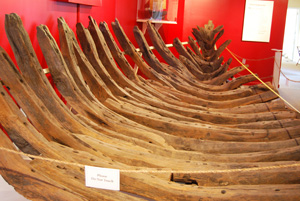
Remains of the Sparrow-Hawk, Cape Cod's Oldest Shipwreck1
Handheld XRF for Non-Destructive In-Situ Analysis of Historic Specimens
Dr. Hayes used the DELTA Standard Handheld XRF Analyzer. This handheld XRF couples a high resolution, large-area silicon drift detector (SDD) with a powerful 4-watt tube to deliver fast and precise compositional analysis of a variety of materials, including metals, alloys, soil, sediment, wood, wood treatments, and fluids. With dramatically reduced testing times, the DELTA allows hundreds of tests per day enabling immediate in-the-field decisions, optimizing any research and discovery budget.
The XRF analysis indicated that the wood absorbed elements from materials it came in contact with over the years. Iron (Fe) could be from original posts and fasteners. Chlorine (Cl) is likely from the salt of the ocean. Elements such as sulfur (S) and calcium (Ca) may be remnants from sea life attached to the wood over time. Silicon (Si) could simply be from sand.
Handheld XRF Methodology for Shipwreck Analysis
Dr. Hayes maps out his analysis objectives for the shipwreck prior to taking measurements. He creates a schematic of the wreck and marks off areas of analytical interest. He then places a measuring tape along the specimen to provide precise analysis locations. He uses a DELTA soil foot and a piece of board to keep the analyzer steady on curved pieces during analysis.
|  Measuring Tape Guided Analysis | 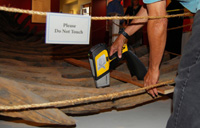 Soil Foot and Board of Balance |
Metal Posts and Fasteners
It is unlikely that any metal from the Sparrow-Hawk would have survived over time simply from scavenging. However, the metal post found in the stern and the metal fasteners found where the rudder attached did have different compositions. The post may have been inserted in the 1860's when it was brought from Cape Cod to be exhibited on Boston Common. The fasteners may have been attached around 1890 when it was transported back to Plymouth.
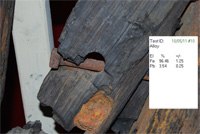 Stern Post | 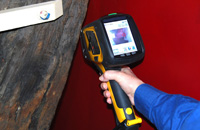 DELTA Camera Shot of Fastener Test | 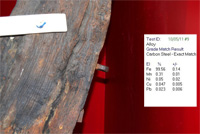 Fasteners Near Rudder Attachment |
This Applications Brief is based on a 2011 Grant awarded to Dr. Ray Hayes. His work involves the analysis of materials used in current and historic ship-building as well as of marine sediment and seawater as an additional source of elemental chemistry in shipwreck specimens. Shipwrecks he has studied span 200 years and encompass a wide variety of densities and origins. Along with adding to the overall knowledge base, Dr. Hayes research on the Sparrow-Hawk may shed more light on its voyage.
References
1: Cape Cod's Oldest Shipwreck, The Desperate Crossing of the Sparrow-Hawk; Mark C. Wilkins; Copyright © 2011 by Mark C. Wilkins; published by The History Press; Charleston, SC 29403; www.historypress.net.
